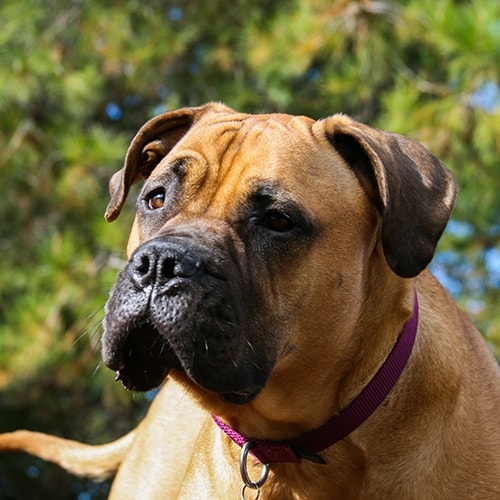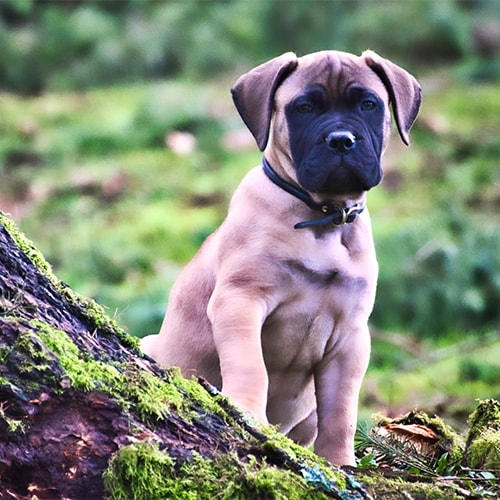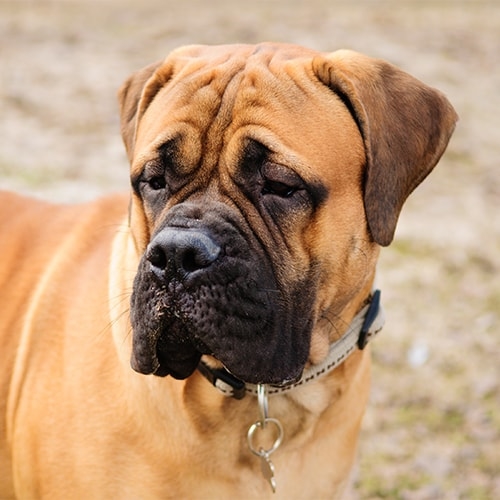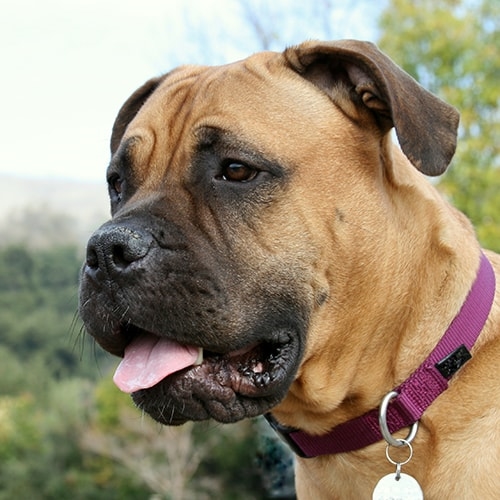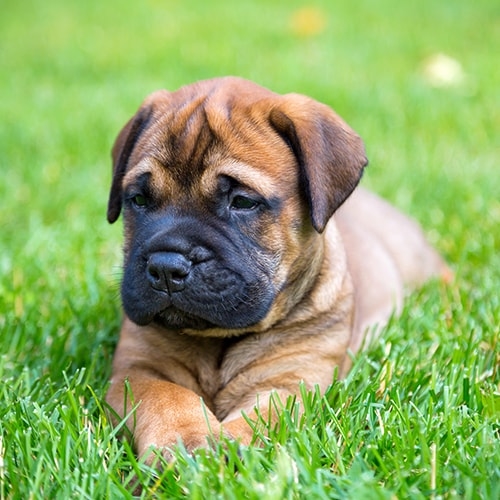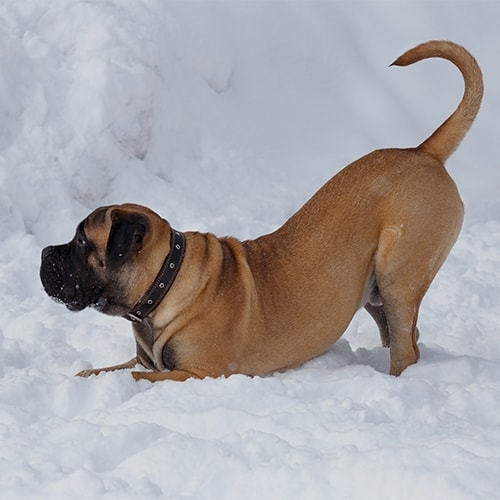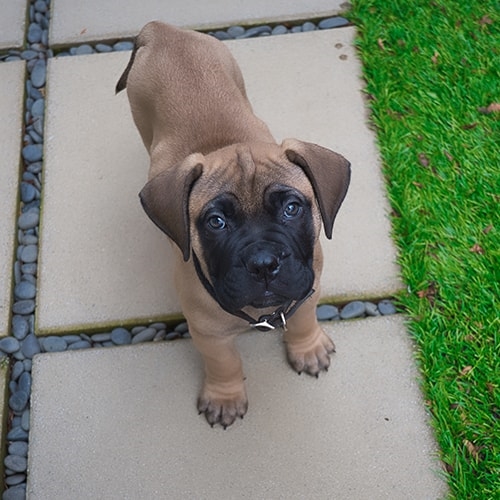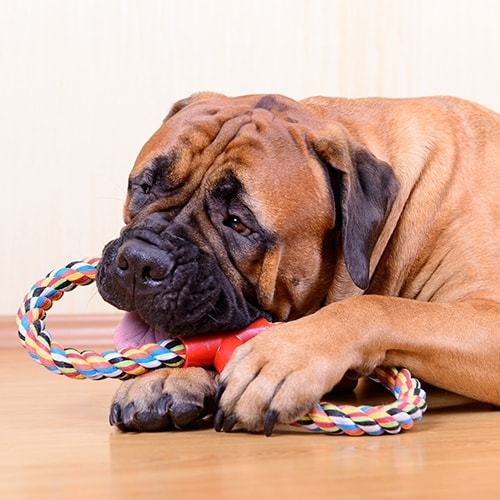| Size | Large |
|---|---|
| Average height | 61-69 cm |
| Average weight | 41-59 kg |
| Average lifespan | Under 10 years |
| Minimum exercise (per day) | 2 hours |
| Coat length | Short |
| Minimum cost (per month) | £105 |
Bullmastiffs are large but gentle dogs who are devoted to their owners. They are known for being real softies around their families despite their intimidating size and love nothing more than being with people they know.
Originally bred to be guard dogs, Bullmastiffs can be very protective of the people they love. Early socialisation is super important with them as they can be suspicious of anyone – and anything – they don’t know.
Common health problems in Bullmastiffs
Bullmastiffs are real gentle giants and can be great in the right household as long as they have the space they need. Unfortunately, like other purebred dogs, they are at risk of certain issues relating to their breed.
If you are thinking of buying a Bullmastiff puppy, make sure the parents of your puppy have had the relevant health screening to reduce the chances of your puppy being affected by certain conditions. We’d recommend looking for a Kennel Club Assured Breeder as they meet extra requirements which will benefit your puppy’s health.
Some of the conditions Bullmastiffs may develop include:
- Gastric Dilatation Volvulus (GDV) – where a dog’s tummy bloats and twists around on itself, which can be fatal.
- Hip dysplasia – where hip joint that doesn’t fit together perfectly, which will eventually lead to arthritis. Before breeding, dogs should be screened by x-rays through the BVA/Kennel Club Hip Dysplasia Scheme.
- Elbow dysplasia – where the elbow joint that doesn’t fit together perfectly, which will eventually lead to arthritis. Before breeding, dogs should be screened by x-rays through the BVA/Kennel Club Hip Dysplasia Scheme.
- Brachycephalic obstructive airway syndrome (BOAS) – this can cause severe breathing problems and is caused by their shorter faces.
- A range of skin infections and conditions
- Eyelid/eye problems – including entropion and ectropion where the eyelid rolls inwards or outwards, irritating the eye.
- Certain cancers.
- PPV (Persistent pupillary membrane) – a condition where additional skin is left across eye that may affect sight. Breeding dogs should be screened for this.
If you want to minimise the risk of your dog getting problems due to exaggerated features, you can read our advice on choosing a pedigree dog.
Caring for your Bullmastiff
Bullmastiffs are sweet and friendly dogs with the people they know well. They can be boisterous – especially when they’re younger – so owners need to be prepared for a large and powerful dog with boundless puppy energy! For this reason, they’re better suited to owners familiar with the needs of the breed.
Like all dogs, Bullmastiffs enjoy the company of their owners and don’t like to be left alone. Bullmastiffs in particular get so attached to their owners that they suffer badly with separation anxiety if they’re left alone. They are better suited to households where someone is around all day – otherwise you might find they start chewing on your furniture and shoes.
Bullmastiffs and barking
Like any dog, your Bullmastiff is likely to make some sort of noise. How vocal they are is down to the individual, their personality and training. This said, Bullmastiffs aren’t widely known for excessive or unnecessary barking. They are likely to alert you of comings and goings – especially when it’s someone they don’t know – but otherwise many owners say they are fairly quiet dogs. If you’re having problems with excessive noise or barking, we recommend seeking the advice of an accredited behaviourist.
Training and socialisation
As part of the working dog group, Bullmastiffs are no strangers to being trained (in particular, for guarding). For this reason, you’ll need to start positive, reward-based training early and set them clear boundaries from a young age. Bullmastiffs are known for being a little headstrong at times so previous experience with the breed is a huge advantage for owners. If you’re a first time owner or don’t have much experience of the breed, you may want to go to training classes with your dog. You can find your nearest online.
Socialising your Bullmastiff from a young age with lots of different people and experiences is super important. Bullmastiffs have strong guarding instincts and can be suspicious of new people (and animals) so the earlier their socialisation starts, the more likely they are to develop into a confident dogs.
Due to their guarding instincts, Bullmastiffs form very strong attachments with their owners and are known to suffer from separation anxiety. Ideally, they need to be in a household where there is someone around all the time to keep them company. You should never leave any dog alone for more than four hours, but your Bullmastiff may not even be able to cope with this.
Exercise
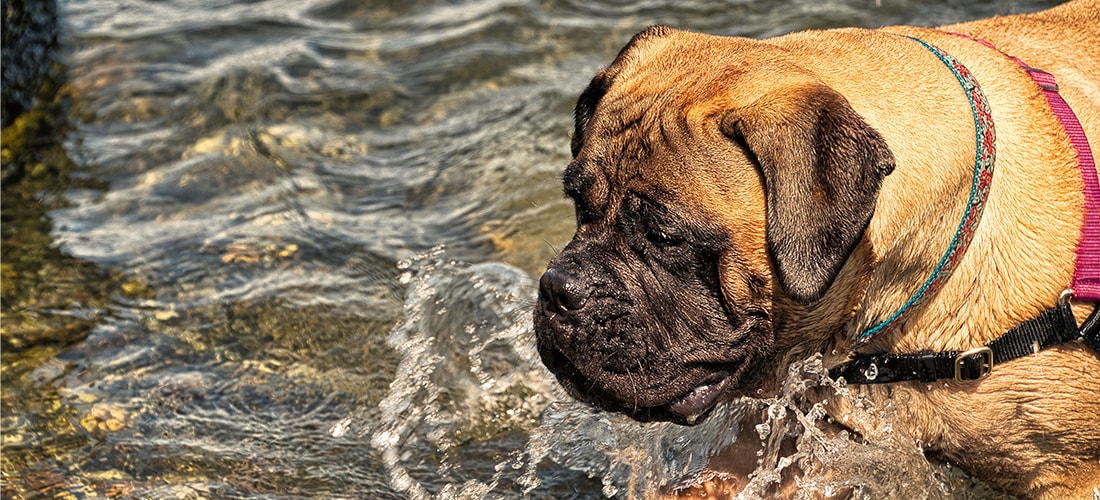
Bullmastiffs are active and playful dogs, especially when they are young. Due to their large size, make sure you don’t overdo it when they are puppies as this can harm their growth and development. As a heavy-set breed, you’ll also need to be careful that you don’t do too much hard exercise – a Bullmastiff isn’t a great choice of running partner!
Your Bullmastiff will need a minimum of two hours exercise every day. Ideally, this will be split into a few walks with off-lead time in a secure area. On top of this, your Bullmastiff will love training sessions with you. They are intelligent dogs and learn quickly, so love a challenge! They’ll also enjoy lots of playtime with you and free time in a large, secure garden.
Grooming
Bullmastiffs have fairly low maintenance coats. A weekly brush should be more than enough to keep on top of dead hairs. While they do shed (like any dog) it’s not known to be excessive. You shouldn’t need to visit a groomer with your Bullmastiff unless they need a bath (due to their large size!).
Remember to keep your Bullmastiff’s face clean and dry. This might need daily attention to avoid getting any nasty infections. Be warned – Bullmastiffs are huge droolers! While they don’t shed much, they definitely make up for it in dribble. You might want to take a cloth out and about for mopping them up.
Bullmastiffs and children
While Bullmastiffs are very loyal to their families, their large size and powerful build isn’t ideal for families with younger children. As they can be energetic and boisterous, there is a risk that they could accidentally bump into children and knock them over. They are better suited to adult-only households or families with older children who understand how to behave around dogs.
You’ll need to supervise your Bullmastiff around children and vulnerable adults. Make sure you can recognise their body language so you can stop playtime if it gets too much for your dog or if they are getting overexcited.
Bullmastiffs and other pets
A well-socialised Bullmastiff should get along fine with other dogs, although they’re not likely to pay much attention to them out and about. They are known to be cautious of unfamiliar dogs so it’s really important to take them to lots of puppy classes and parties while they are young. This will help them see other dogs as friends, rather than something to be concerned about!
Bullmastiffs have very strong prey drives, so we wouldn’t recommend having them with smaller pets. They may get used to another pet they have grown up with, but it’s important that you never leave them alone together.
Food
Your Bullmastiff’s diet will vary depending on their age. You’ll need to feed them a complete, balanced dog food to keep them slim and healthy.
Your vet will be able to tell you how much your Bullmastiff should be eating. You should feed them a good quality, commercially available, complete dog food. Keep in mind that, being a larger dog, your Bullmastiff is likely to need more food than smaller dogs! We usually recommend splitting their daily allowance into two meals. If you give your dog the occasional treat or use treats for training, remember to take this into account and reduce their daily allowance. Treats shouldn’t make up more than 10% of their daily calorie intake as this can unbalance their diet.
You should try to feed your dog at the same time every day to get them into a routine. Remember to leave at a gap after eating and before exercising. Larger breeds like Bullmastiffs are at risk of GDV (bloat) so leaving this gap is really important.
The cost of owning a Bullmastiff
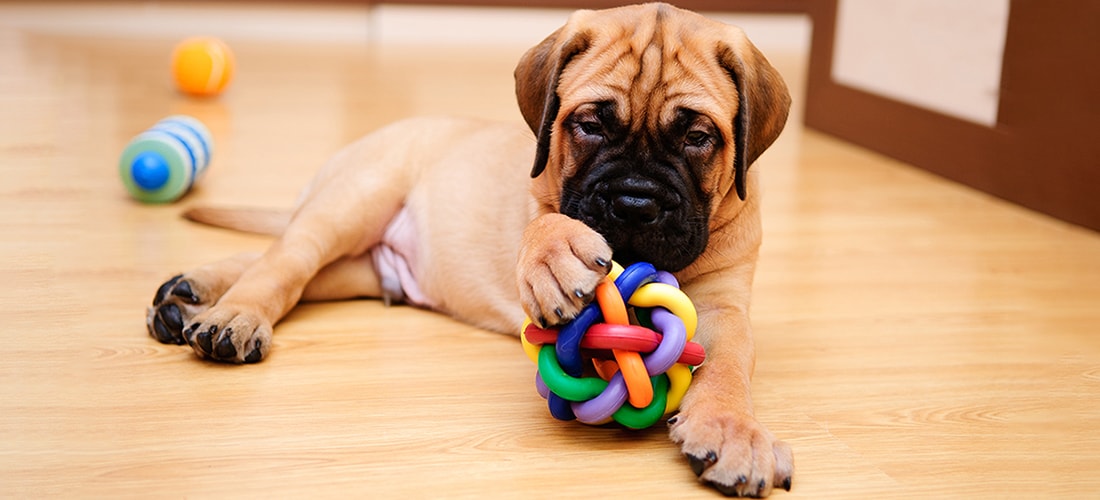
You can expect your Bullmastiff to cost you a minimum of £105 per month after purchase and set-up costs and over £17,000 across their lifetime.
Costs you’ll need to think about include:
Purchase costs
Adopting an adult Bullmastiff from a rescue centre may be a more cost-effective option, with the added advantage of giving a home to a pet without one – check if the rehoming centre you’re looking at asks for a donation for rehoming.
If instead you’re buying a Bullmastiff puppy from a breeder, you’ll need to factor in this cost. Beware unusually cheap puppies as they could come from a puppy farm. If you’d like to buy a pedigree puppy, we recommend looking for a Kennel Club Assured breeder. These breeders must do extra health tests and meet high standards.
Set-up costs
- Puppy vaccines – if you rescue a dog, reputable centres will often vaccinate them for you. Remember that ongoing booster vaccinations will be needed to continue their immunity.
- Neutering – you should usually arrange for your dog to be neutered at around 6-12 months old, though your vet will be able to advise you exactly when is best. Check prices at your local practice as these will depend on your vet and where you live. Some rescue centres will neuter any dogs they rehome, saving you this cost.
- Equipment – including a collar and tags, lead, harness, dog beds, dog bowls, pet-safe toothpaste and toothbrushes, grooming brushes and toys. Keep in mind that all these will need to be replaced with wear or damage or if your dog outgrows or damages them!
Ongoing costs
- Food.
- Preventive healthcare – budget for routine vet visits to help stop your dog getting ill and catch any problems early. They need annual check-ups, vaccinations and regular flea and worming treatments. Check if your vet offers a health care plan as this can help spread the cost throughout the year.
- Vet bills* or pet insurance – if you don’t have pet insurance and your dog needs veterinary treatment for an injury or illness, costs can rapidly mount up. Check what’s covered and what isn’t when comparing policies.
- Accessories – including lots of poo bags, replacing worn toys and grooming accessories, buying doggy toothpaste and any other extras they might need.
Other costs
- Training – basic training is very important and dogs can benefit from formal classes. Some dogs may have, or develop, behavioural problems which might need professional management.
- Boarding – you may also need to budget for boarding or dog sitting costs if you are planning to go away from home on holiday.
- Dog walkers/day-care – you might consider a professional dog walker to keep your dog happy and healthy if you're unable to get out with your dog enough yourself, or to look after them during the day if you need to be out for more than four hours.
* It’s always better to plan ahead and budget or get pet insurance in case your pet gets injured or unwell. If you are having difficulty with veterinary costs, you can check if you are eligible for treatment at PDSA here.
If you’re considering pet insurance, our PDSA Pet Insurance could be a great option for you and it’s quick and easy to get a quote online.
Fun facts
- Bullmastiffs were bred to be guard dogs, but were also trained not to bite intruders but instead keep them where they were until they could be arrested.
- While Bullmastiffs are known for their courage and fearless natures, they’re also known for being huge softies!
- They are an English breed, originally created by crossbreeding the Bulldog and (now extinct) Old English Mastiff.
- Their guarding instincts are still strong – some Bullmastiffs have been known to drive unfamiliar animals out of their owner’s garden!
Getting a Bullmastiff
Do plenty of research before getting a Bullmastiff. These fearless dogs are known to have very sweet natures and need an owners who understands them and their needs. They need plenty of space and exercise to be happy and healthy. If you have the time to give, you’ll get a loyal and devoted companion in return.
Rehoming centres
There are plenty of rescue centres across the country where you may find a Bullmastiff. Breed-specific rescues that specialise in Bullmastiffs are also out there. You’ll need to ask any rescue centre about the dog’s history to make sure they will be comfortable in your home. Good rescue centres should let you know of any health and behaviour problems.
Breeders
If you buy from a breeder, make sure your puppy will be well socialised and have all necessary screening tests, health checks and vaccinations. It’s really important that Bullmastiff puppies from a breeder get the right early socialisation so always ask the breeder about how they go about this. We recommend looking for a Kennel Club Assured breeder as they meet higher standards. We’ve put together some advice to help you find a good breeder.
Not sure if a Bullmastiff is the right pet for you?

